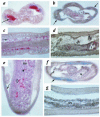Tetracycline therapy targets intracellular bacteria in the filarial nematode Litomosoides sigmodontis and results in filarial infertility
- PMID: 9884329
- PMCID: PMC407866
- DOI: 10.1172/JCI4768
Tetracycline therapy targets intracellular bacteria in the filarial nematode Litomosoides sigmodontis and results in filarial infertility
Abstract
Intracellular bacteria have been described in several species of filarial nematodes, but their relationships with, and effects on, their nematode hosts have not previously been elucidated. In this study, intracellular bacteria were observed in tissues of the rodent parasite Litomosoides sigmodontis by transmission electron microscopy and by immunohistochemistry using antiendobacterial heat shock protein-60 antisera. Molecular phylogenetic analysis of the bacterial 16S ribosomal RNA gene, isolated by PCR, showed a close relationship to the rickettsial Wolbachia endobacteria of arthropods and to other filarial intracellular bacteria. The impact of tetracycline therapy of infected rodents on L. sigmodontis development was analyzed in order to understand the role(s) these bacteria might play in filarial biology. Tetracycline therapy, when initiated with L. sigmodontis infection, eliminated the bacteria and resulted in filarial growth retardation and infertility. If initiated after microfilarial development, treatment reduced filarial fertility. Treatment with antibiotics not affecting rickettsial bacteria did not inhibit filarial development. Acanthocheilonema viteae filariae were shown to lack intracellular bacteria and to be insensitive to tetracycline. These results suggest a mutualistic interaction between the intracellular bacteria and the filarial nematode. Investigation of such a mutualism in endobacteria-containing human filariae is warranted for a potential chemotherapeutic exploitation.
Figures




References
-
- Fiftieth World Health Assembly. 1997. Elimination of lymphatic filariasis as a public health problem. World Health Assembly. Geneva, Switzerland. 1–2.
-
- World Health Organization. 1997. Chagas disease, leprosy, lymphatic filariasis, onchocerciasis: prospects for elimination. World Health Organization. Geneva, Switzerland. 11–21.
-
- Albiez EJ, et al. Histological examination of onchocercomata after therapy with ivermectin. Trop Med Parasitol. 1988;39:93–99. - PubMed
-
- Prichard R. Anthelmintic resistance. Vet Parasitol. 1994;54:259–268. - PubMed
-
- McLaren DJ, Worms MJ, Laurence BR, Simpson MG. Micro-organisms in filarial larvae (Nematoda) Trans R Soc Trop Med Hyg. 1975;69:509–514. - PubMed
Publication types
MeSH terms
Substances
LinkOut - more resources
Full Text Sources
Other Literature Sources
Research Materials

